Protecting Public Safety After New York State Rifle & Pistol Ass’n v. Bruen
Hearing before the U.S. Senate Committee on the Judiciary
March 15, 2023
Amy E. Swearer
Senior Legal Fellow, Edwin Meese III Center for Legal and Judicial Studies
The Heritage Foundation
Chairman Durbin, Ranking Member Grassley, and distinguished Senators,
My name is Amy Swearer, and I am a Senior Legal Fellow in the Heritage Foundation’s Edwin Meese III Center for Legal and Judicial Studies. My areas of scholarship and study include, among other things, the Second Amendment, school safety, and the intersection of gun violence and mental health. I was a primary author of Heritage’s recent e-booklet, The Essential Second Amendment, and run the organization’s Defensive Gun Use Database. I have testified numerous on firearms policy at both the state and federal level, including on several occasions before this Committee. Most recently, these testimonies have covered an array of proposed gun control measures, recent nationwide spikes in violent crime, keeping the nation’s children safe from gun violence, and the economic toll of gun violence.REF
Today, I have been asked—along with my fellow panelists—to discuss how Congress can protect public safety after the Supreme Court’s opinion this past summer in New York State Rifle and Pistol Association v. Bruen. The very title of the hearing implies that, as a result of the Bruen opinion and subsequent Second Amendment litigation, the public safety is endangered.
What an absurd premise.
To be clear, this mild insinuation that Bruen endangers public safety is quite tame compared to the hysterical theatrics employed by some media outlets and public figures. At various points after the opinion’s release, pundits and policymakers have alleged, among other things, that Bruen:
- is a radical gun ruling that will lead to more violence;REF
- will have significant and dangerous consequences for New Yorkers, including law enforcement officers;REF
- is reckless, reprehensible, and shows an extreme vision for life in the United States;REF
- asserts that nearly any attempts at gun regulation are invalid;REF
- will literally get women killed.REF
The good news is that Bruen does none of these things.
In fact, in its most immediate impact, Bruen is likely to increase public safety by striking down laws that for far too long effectively prohibited ordinary, peaceable citizens from carrying firearms in public to defend themselves against violent victimizations. Defensive gun uses have a significant protective impact against violent crime—a protective impact which will now finally be fully extended to millions of residents in the seven states whose public carry frameworks formerly rendered most of them defenseless victims.
Yes, it is likely that when the dust of the post-Bruen legal fallout settles, several modern gun control laws will be struck down as unconstitutional (most of which should have been struck down under a fair application of Heller and McDonald). But these laws overwhelmingly failed to offer significant public safety benefits in the first place, and precisely for the reasons they will likely be struck down—in practice, they most commonly target peaceable Americans while doing very little to ensure that violent criminals are effectively deterred or prevented from committing violent acts.
At the same time, Bruen leaves ample room for the enforcement of a variety of public safety measures that are far more effective than the “just do something” laws it threatens. This is abundantly clear in those cases where courts have thus far struck down gun control statutes post-Bruen. In each those cases, the court points out constitutionally permissible measures (like pre-trial detainment) that could have been but were not, in fact, used against the defendant, who then went on to simply ignore the stricken law.
I. Understanding Bruen: How Did We Get There and What Does It Actually Say?
Bruen was, in many ways, a much-needed correction to lower courts’ widespread refusal to treat District of Columbia v. HellerREF and McDonald v. City of ChicagoREF with any semblance of respect. In those landmark cases, the Supreme Court struck down bans on the possession of operable handguns inside the home. Taken together, Heller and McDonald affirmed that the right to keep and bear arms is, indeed, individual in nature and centered on the natural right of self-defense.REF The Second Amendment does not protect a second-class right, but one that is fundamental to our scheme of ordered liberty and applicable against the states through the Fourteenth Amendment.REF At the very least, law-abiding, peaceable adult citizens have a right to own arms that are of a type commonly possessed by such citizens for lawful purposes.REF
Notably, the Court declined in both cases to explicitly adopt or apply a “tiers of scrutiny” framework, but deemed means-end interest balancing tests to be inappropriate and focused its analysis on the Amendment’s text, history, and tradition.REF It emphasized that nothing in either opinion should be understood as “casting doubt” on “certain longstanding” and “presumptively lawful” restrictions.REF These included prohibitions on firearm possession by felons or the mentally ill, laws restricting the carrying of firearms in “sensitive places” like schools and government buildings, or laws imposing conditions and qualifications on the commercial sale of firearms.REF
And then, for the next decade, the Court declined every opportunity to put flesh onto this bare bones Second Amendment framework. In the interim, lower courts developed a two-step approach that, in effect, led courts at the second step to use intermediate scrutiny to engage in the very type of means-end interest balancing the Supreme Court deemed inappropriate. Under this test, Heller and McDonald were effectively rendered toothless, and many lower courts never found a gun control law they could not uphold under the second step.REF
New York State Rifle & Pistol Association v. BruenREF was the Supreme Court’s first major attempt to clarify (and vindicate) Heller and McDonald, and address at least some of the questions those cases left unanswered—namely, what is the scope of the right to bear arms outside of the home and what, exactly, is the framework courts should use when analyzing Second Amendment challenges. New York generally prohibited civilians from possessing a firearm outside of their homes without an unrestricted concealed carry permit, which allows a person to “have and carry” a concealed handgun in public. Applicants for this license needed to prove to the state that they had “proper cause” for being armed in public, meaning they had a “special need for self-protection distinguishable from that of the general community.” In practice, this proper-cause requirement worked to ensure that ordinary, law-abiding New Yorkers did not have a right to armed self-defense outside the home. Lower courts had upheld the constitutionality of the proper-cause standard both in New York and six other states with similar frameworks, uniformly justifying the requirement under some form of heightened scrutiny.
In Bruen, the Supreme Court struck down New York’s “proper cause” requirement, holding that the Second and Fourteenth Amendments protect an individual’s right to carry a handgun outside the home for self-defense.REF Just as importantly, the Court outright rejected the two-step test developed by lower courts in the wake of Heller and McDonald, finding in particular that the second step is “inconsistent with Heller’s historical approach and its rejection of means-end scrutiny.”REF Instead, it adopted the following standard for Second Amendment cases:
When the Second Amendment’s plain text covers an individual’s conduct, the Constitution presumptively protects that conduct. The government must then justify its regulation by demonstrating that it is consistent with the Nation’s historical tradition of firearm regulation. Only then may a court conclude that the individual’s conduct falls outside the Second Amendment’s ‘unqualified command.’REF
The Court explained that while courts are required to reason through historical analogy, this is “neither a regulatory straightjacket nor a regulatory blank check.”REF Courts should neither uphold every modern law that remotely resembles a historical analogue nor require the government to produce a historical twin or “dead ringer” for a modern law. According to the Court, Heller and McDonald pointed toward at least two central metrics for a historical analogical inquiry: “whether modern and historical regulations impose a comparable burden on the right of armed self-defense and whether that burden is comparably justified.”REF
In short, New York’s proper cause requirement did not fit within the confines of those “reasonable, well-defined restrictions” that historically delineated the outer limits of the right of peaceable, law-abiding adult citizens to bear commonly used arms in public for self-defense. While there is a longstanding tradition of limiting the intent for which one could carry arms in public, the manner by which one could carry arms in public, or the exceptional circumstances or sensitive places in which one could not carry arms, there was simply no historical analogue limiting public carry only to those law-abiding citizens who demonstrate a special need for self-defense.REF
Importantly, the Court explicitly stated that nothing in its holding “should be interpreted to suggest the unconstitutionality” of the shall-issue frameworks already employed by a majority of states and which do not require an applicant to prove an atypical need for self-defense.REF At the same time, it did not “rule out constitutional challenges to shall-issue frameworks” whose bureaucratic burdens may nonetheless work to deny ordinary citizens their right to public carry.REF
II. Bruen’s Most Direct Impact—Striking Down “Proper Cause” Carry Statutes—Promotes Both Public Safety and a Fairer, More Equitable Criminal Justice System
The most immediate and direct impact of Bruen is that it struck down “proper-cause” requirements in seven states, effectively forcing those states to become “shall issue” for purposes of concealed carry permits. While some have decried the prospect of a more concealed carry permit holders carrying guns in public places, insinuating that this will exacerbate violent crime problems, this is inconsistent with the evidence. Rather, because of Bruen, millions more peaceable Americans will have the option of lawfully defending themselves and others with a firearm in public, something that promotes the public safety. Moreover, because states may no longer arbitrarily prohibit public carry for ordinary Americans, fewer peaceable citizens are likely to find themselves branded “violent weapons offenders” for having the audacity to defend themselves in public without a government license they could never hope to obtain.
A. Peaceable Citizens Benefit from the Right to Armed Self-Defense, Both at Home and in Public Spaces
In general, lawful gun owners are not the driving force behind criminal gun violence.REF It is universally true that most gun crimes are committed by a very small subset of serial offenders who are already prohibited from legally possessing firearms.REF While some lawful gun owners will inevitably use their firearms in furtherance of criminal activity in any given year, the overwhelming majority will not.REF This is particularly true of concealed carry permit holders, who are as a group one of the most law-abiding populations in the nation. Analyses of available state-level data routinely shows that they are, in fact, significantly less likely to be convicted of firearms-related violations than are police officers, who under federal law are exempt from most state-level gun laws (including those regulating public carry), including while they are off-duty.REF This is not to suggest that law enforcement officers are prone to committing weapons offense—quite the opposite, it highlights just how little the public has to fear from an increase in concealed carry permit holders.
Given this reality, it is little wonder that the most methodologically sound studies on the issue routinely find that more permissive public carry schemes do not lead to more violent crime.REF To the extent that any studies do show a relationship between public carry frameworks and violent crime, there still exists no logical causal mechanism to explain how more permissive public carry laws would conceivably cause that violent crime. The only crimes that could logically be the result of permissive public carry laws are those (1) carried out with firearms (2) in public places (3) by a person lawfully carrying that firearm under the permissive framework (4) who would not otherwise have been highly motivated to commit the same crime regardless of whether state laws prohibited him or her from carrying in public. Most crimes (in fact, the vast majority of crimes) do not fit within those parameters. And, again, concealed carry permit holders are overwhelmingly law-abiding and rarely commit any crimes, much less gun crimes in public spaces that were facilitated by their carry permits in the sense that permit holder committed a crime of opportunity during the normal course of his or her otherwise lawful public carry. Moreover, to the extent that permit holders sometimes do commit these types of crimes, it is equally true that they are sometimes stopped by other armed citizens whose ability to defend themselves and others is owed directly to the more permissive public carry framework.REF
Indeed, gun violence rates plummeted between the early 1990s and late 2010s, even as the national momentum shifted dramatically toward more permissive public carry schemes.REF Not a single state that voluntarily moved to a more permissive framework has chosen to return to its more restrictive laws. Since most individuals who own guns or carry them in public do so out of concern for their own safety, it is far more likely (and the available evidence certainly suggests) that any causal mechanism works the opposite way—increases in violent crime tend to cause states to move toward less restrictive frameworks so that law-abiding citizens may better defend themselves in public, and not the other way around.
Just as advocates of stricter public carry laws often overstate concealed carry permit holders’ contribution to violent crime, they often seriously downplay (or completely ignore) the protective impact of lawful gun ownership. According to a 2013 report by the Centers for Disease Control and Prevention, almost every major study on defensive gun uses has concluded that Americans use their firearms defensively somewhere between 500,000 and several million times every year.REF In 2021, the most comprehensive survey of gun owners and gun use ever conducted reinforced these earlier studies, estimating an average of just over 1.6 million annual defensive gun uses.REF Importantly, this latest analysis reveals that, unlike criminal gun uses, defensive gun uses are quite common amongst lawful gun owners, with approximately one-third of all gun owners reporting having used a firearm to defend themselves or their property.REF Moreover, while many of these defensive gun uses occur in or around the gun owner’s home, 14 percent (or approximately 224,000) occurred either in public or in a third-party residence.REF The number of defensive gun uses outside of the home has likely been kept artificially low by overly restrictive public carry schemes like the one struck down in Bruen, precisely because these laws all but ensured that tens of millions of ordinary, law-abiding adults would never have the option of lawful armed self-defense in public spaces.
Not only are armed civilians better able to resist criminal activity when it occurs, but according to criminals themselves, knowing that potential victims might be armed effectively deters many crimes from happening in the first place. According to one survey of imprisoned felons, roughly one-third reported being “scared off, shot at, wounded or captured by an armed victim,” while 40 percent admitted that they had refrained from attempting to commit a crime out of fear that the victim was armed.REF Well over half of the surveyed felons acknowledged that they would not attack a victim they knew was armed, and almost three-quarters agreed that “one reason burglars avoid houses where people are at home is that they fear being shot.”REF Importantly, the study also found that felons from states with the greatest relative number of privately owned firearms registered the highest levels of concern about confronting an armed victim.REF
This is consistent with the conclusions of a study that analyzed the effect of a Memphis newspaper listing all Tennessee residents with a handgun carry permit in a publicly accessible database, locating them within their five-digit zip code. The database received more than a million views in 2009.REF The study’s authors concluded that, in the months following a newspaper article that dramatically increased online traffic to the database, zip codes with higher densities of carry permit holders experienced a 20 percent relative decrease in burglaries compared to zip codes with lower densities of carry permit holders.REF
International data, too, seems to indicate that criminals generally consider the likelihood of armed resistance and adapt their behavior accordingly. According to one study, only about 13 percent of burglaries in the United States take place when the occupants are home, a rate far lower than in many other developed countries like Canada, Great Britain, and the Netherlands.REF Because these “hot burglaries” are far more likely to result in an assault against a victim than are burglaries of unoccupied homes, it is relatively easy to predict—as several researchers have—that the lower percentage of hot burglaries in the United States results in over half a million fewer assaults every year than would otherwise occur if the percentage of hot burglaries was on par with these other countries, saving the nation billions of dollars in avoided crime costs and an untold number of lives.REF While these studies looked specifically at burglaries, which by definition do not occur in public, it should be presumed that the same protective effects of gun ownership extend (at least to some extent) to the public sphere based on the same logic—most criminals seek to avoid armed resistance and in many cases will be deterred from attacking victims in a public place if those victims are likely to be armed.
Additionally, armed civilians play a significant but underacknowledged role in stopping active shooters, including those bent on committing acts of mass public violence. Between 2014 and 2021, armed citizens successfully stopped 51 percent of active shooters who carried out attacks in public places that allowed civilians to lawfully carry their own firearms for self-defense.REF In none of those incidents did the armed citizen injure innocent bystanders.REF
Finally, armed self-defense—including armed self-defense in public—is often a vital but overlooked part of ensuring the safety of victims of intimate partner domestic violence. As explained below, too often, perpetrators of intimate partner domestic violence are simply told by a court not to contact or harm their victims, but are otherwise not detained. Far too often, they are not even prosecuted for their crimes until after they violate restraining orders. According to my analysis of the Heritage Foundation’s Defensive Gun Use Database, between January 1, 2021 and March 10, 2022, we recorded 208 media-verified instances in which victims of intimate partner were protected from an abuser solely because they or a third-party was lawfully armed with a gun. In total, these armed citizens protected an estimated 395 potential victims, including 65 minor children and three unborn children. In 24 cases, the victim had a restraining order against the abuser, which was ignored. In 15 additional cases, it was clear that the assailant had a significant history of domestic violence, and in three cases, the victim was in the process of obtaining or renewing a protective order.
Our database is limited, and almost certainly undercounts by several orders of magnitude the actual number of times armed civilians successfully defend domestic violence victims from further abuse. First, our database relies solely on publicly accessible, online media reports that provide enough information to conclude that a particular DGU occurred during an incident of domestic violence involving partners. Often, media reports on DGUs fail to provide enough information for us to make reasonable determinations about the specific context in which the DGU occurred, or about whether the defensive gun user acted in an entirely lawful manner.
There is also good reason to believe that most defensive gun uses (in any context) are either not reported to police or are not considered “newsworthy” enough by local reports to garner a newspaper article.REF Notably, our list almost exclusively involves situations where a gun was not just fired defensively, but where the assailant was injured or killed. It is impossible to know how many women are protected each year during defensive gun uses that are less likely to be reported in a public media source—like, for example, scenarios where the assailant is warded off by a warning shot or by the victim’s mere presentation of a firearm.
At the very least, these verified defensive gun uses underscore the importance of the Second Amendment in protecting victims of domestic violence from their abusers. Far too often, civilian gun possession is framed as contrary to the interests of domestic violence victims. While it is certainly true that armed domestic abusers present a serious threat to their victims, it is also true that armed civilians routinely present a serious threat to would-be abusers.
Additionally, despite common suggestions by some prominent gun control advocates that armed domestic violence victims routinely have their firearms taken and used against them by their abusers, this is not supported by the available evidence. Such tragedies have, of course, occurred. But they are exceedingly rare, especially when compared to the number of successful defensive gun uses. Between our records of cases excluded from the Heritage database for being unsuccessful and the records available from the Gun Violence Archive—which flags instances of domestic violence involving guns stolen from their owners—we have been able to find only five cases since January 1, 2021, that even remotely fall into this category. In only one of these cases did an abuser overpower his armed victim, take her gun, and immediately use it against her to cause death or serious bodily injury.REF In a second case, the abuser confronted the victim while she was not armed, demanded that she hand over the gun he knew she possessed for protection against him, and then used the gun to fatally shoot her nearly two weeks later.REF In three other cases, a victim’s gun was taken but the abuser either did not attempt to use the gun against the victim or did not successfully use the gun against the victim.REF
B. Overly Restrictive Public Carry Laws Have Devastating Criminal Justice Consequences
Not only does Bruen better enable peaceable citizens to defend themselves and others in public, it strikes down some of the worst aspects of discretionary, restrictive public carry frameworks that too often resulted in the government perversely creating “violent weapons offenders” out of otherwise law-abiding, upstanding citizens. As a coalition Black defense attorneys highlighted in an amicus brief in support of the petitioners in Bruen, New York’s licensing requirements effectively criminalized the exercise of fundamental rights, in particular for poor and non-white Americans.REF It was almost impossible for them to obtain a license to carry because licensing officials almost always determined that they lacked proper cause or sufficiently good moral character. And yet, because many still nonetheless truly felt a need to protect themselves with firearms in public despite government assessments to the contrary, or because they simply could not afford the often-prohibitive fees the government requires, thousands of New Yorkers were prosecuted every year as felons for possessing guns without licenses.REF Nearly all of them were ethnic minorities.REF In many cases, this is the only crime they were ever alleged to have committed. Now, at the very least, there is some method for ordinary peaceable New Yorkers to exercise their fundamental rights in a non-criminal manner.
Unfortunately, even shall-issue states sometimes make it too difficult for ordinary, law-abiding citizens to obtain and carry firearms in public, resulting in the same criminal justice problems. A recent study from Loyola University on arrests for illegal gun possession in Cook County helps to demonstrate the punitive effect of Illinois’ burdensome process for obtaining a concealed carry permit.REF A significant percentage of individuals arrested for illegal firearm possession are not otherwise prohibited from possessing guns and are not accused of using their gun in a violent manner or in furtherance of a crime. Their sole offense was a failure to obtain a concealed carry permit, something that under Illinois law they—as non-prohibited persons—could in theory obtain. The question is why individuals who want to carry in public and would actually qualify for the permit to do so nonetheless fail to obtain one. The answer seems to be, in large part, that obtaining a carry permit in Illinois will cost hundreds of dollars, require a working knowledge of the legal process, and impose serious time and logistical burdens.
III. The Post-Bruen Legal Fallout Is Widely Mischaracterized and Its Potential Public Safety Consequences Grossly Exaggerated
With respect to the post-Bruen legal fallout, this hearing is probably at least six months premature. The most significant post-Bruen challenges are still working their way through the lower courts, and will likely take several more months (if not years) to fully resolve. That said, it is almost certain that Bruen will ultimately threaten certain types of modern gun control laws. The current extent of the post-Bruen legal fallout can be generally categorized into two groups: (1) cases dealing with public carry frameworks (most of which are in formerly “proper cause” states), and (2) cases in which more modern 20th century laws have been challenged. In each of these cases, the holdings and practical effects have been widely mischaracterized by gun control advocates and liberal academics, and the potential public safety consequences grossly exaggerated.
A. Successful Challenges to Post-Bruen Public Carry Frameworks in Formerly “Proper Cause” States
After Bruen, some formerly proper-cause states responded by merely suspending that requirement and leaving in place other time, place, and manner restrictions, which generally brought their public carry permit frameworks in line with the more restrictive and burdensome shall-issue jurisdictions. Others, however, seemingly went out of their way to take out their frustrations over the Bruen decision on law-abiding concealed carry applicants. New York and New Jersey are two prime examples. They immediately implemented extensive changes to their public carry laws that were obvious attempts to circumvent and undermine key aspects of Bruen.
Since these states could not use its discretion to determine whether an applicant had a “proper cause” to exercise his or her Second Amendment rights in public, they pivoted to insisting that applicants must still prove they are of sufficiently good “moral character.” Licensing officers still reserve all the discretion in the world to determine whether an applicant meets that standard (a standard that, of course, is not based on objective measures of character such as criminal history or evidence of dangerousness). Applicants in New York, specifically, have to provide lists of all current and past social media accounts, the names and contact information of family members and cohabitants, at least four character references, and basically any other information a licensing officer decided might be relevant.
While the Court in Bruen said that New York could not deem the entirety of the public arena a “sensitive place,” both it and New Jersey did their darnedest to deem off limits as many public places as possible. Among other things, these states created a default presumption that a permit holder may not carry a firearm on to any third-party private property (including businesses open to the public) without explicit permission from the third-party—a presumption that all but ensures permit holders will not be allowed to bear arms in almost any area outside of their homes.
To the extent that some courts have enjoined parts of these post-Bruen public carry frameworks, it is because they largely fall far outside of the norms of the shall-issue frameworks identified in Bruen as presumptively constitutional. And, notably, most of New York’s post-Bruen restrictions are still in place after the Second Circuit issued stays with respect to almost all aspects of the temporary restraining orders.REF Oral argument is scheduled for March 20. It is likely that these more extreme aspects of New York’s new framework will ultimately be struck down as inconsistent with Bruen, though likely by virtue of a “grant, vacate, and remand” order from the Supreme Court and not the Second Circuit, which, like the Ninth Circuit, is notorious for having never found a gun control measure that it could not find perfectly compatible with the Second Amendment.REF
This will not, however, create serious public safety concerns. Again, concealed carry permit holders are overwhelmingly law-abiding and are not the driving force behind gun crimes. These were not restrictions on public carry that New York, New Jersey, or others deemed necessary for maintaining public safety until after Bruen. That is because these brand-new restrictions are not about public safety in the first place. They are nothing more than cynical efforts to ensure that the concealed carry process is so convoluted, burdensome, and restrictive that many residents will simply decline to waste time and money obtaining a permit that does not actually seem to allow them carry anywhere outside of their homes. They are the very types of Kafkaesque bureaucratic burdens with abusive ends that the Bruen majority maintained would open a shall-issue regime to constitutional challenge.REF If and when these provisions are finally struck down, and New York and others are made to fall in line with other shall-issue states, the only effect on public safety will be an increased opportunity for peaceable citizens to defend themselves in public.
There has been, to my knowledge, only one successful post-Bruen challenge to public carry laws that pre-dated Bruen. In August of 2022, in Firearms Policy Coalition v. McCraw,REF the U.S. District Court for the Northern District of Texas enjoined a Texas statute prohibiting law-abiding 18-to-20-year-old from obtaining a license to carry a handgun outside of the home for self-defense.REF The court determined that law-abiding 18-to-20-year-olds are part of “the people” mentioned in the Second Amendment, and that the wholesale prohibition on their bearing handguns in public was not consistent with the Nation’s historical tradition of firearm regulation, as required by Bruen.REF The court started its analysis by noting that the Second Amendment does not mention any sort of age restriction, and that “when the Framers meant to impose age restrictions, they did so expressly.”REF Heller made clear that “the people” is a term of art referring “all members of the political community, not an unspecified subset,” and in Bruen it was undisputed that “ordinary, law-abiding, adult citizens” are part of the “people” whom the Second Amendment protects.REF Moreover, while the Second Amendment protects an individual right regardless of whether he or she is actively engaged in militia service, “logic demands…that the Second Amendment’s protections extend at least to those who constitute the militia…[I]t must protect at least the pool of individuals from whom the militia would be drawn.”REF This was generally understood at the Founding to include able-bodied 18-to-20-year-olds.REF
Texas’ scheme did not, like historical analogues, distinguish between methods of carrying a firearm in public (such as openly versus concealed), prohibit carrying only in certain “sensitive places,” involve the carrying of “dangerous and unusual” arms, or deal with gun ownership by felons or the mentally ill. While laws restricting certain rights of individuals under the age of 21 were enacted in some jurisdictions during the latter half of the 19th century, the court recalled that Bruen “should not be understood to endorse freewheeling reliance on historical practice” from that period “to establish the original meaning of the Bill of Rights.”REF Rather than appeal, Texas settled the case and changed its concealed carry permitting scheme to allow applications from law-abiding residents aged 18 or older.REF
Notably, at least one federal circuit has already disagreed with McCraw’s reasoning, though in a case dealing with the slightly different (but very much related) issue of laws prohibiting gun sales to young adults.REF However, should the reasoning in McCraw ultimately win the day (an outcome that is perfectly reasonable under a fair application of Bruen), the sky will still not fall. As with restrictive public carry laws implemented by formerly “proper cause” states after Bruen, there are few negative public safety implications for allowing law-abiding 18-to-20-year-olds to obtain permits to carry firearms in public for self-defense on the same basis as other law-abiding adults.
B. Successful Challenges to Non-Public Carry Gun Laws Based on Bruen Framework
There have also been a handful of successful post-Bruen challenges to gun laws unrelated to public carry. While these cases are still working their way through litigation and additional appeals, they do provide meaningful insight into how Bruen may operate to strike down certain types of gun control laws. Importantly, they also provide valuable insight into the types of laws that lower courts generally agree Bruen leaves untouched.
United States v. Quiroz.REF One month after McCraw, in September of 2022, the U.S. District Court for the Western District of Texas dismissed an indictment under 18 U.S.C. § 922(n), which prohibits those under felony indictment from “receiving” (but not possessing) firearms or ammunition. The court reasoned that the federal statute does not “align with the Nation’s historical tradition,” as required by Bruen.REF In this case, the defendant was under felony indictment in Texas state court for both burglary and for jumping bail with respect to that burglary charge. While under indictment, he attempted to buy a firearm from a licensed firearms dealer, during which transaction he denied being under felony indictment when filling out his required ATF Form 4473. Because of a delayed background check, the defendant was able to acquire the firearm before the denial came back to the dealer. Shortly thereafter, the Bureau of Alcohol, Tobacco, Firearms, and Explosives was informed of the illegal firearm acquisition. The defendant’s firearm was seized, and he was charged and ultimately convicted of violating § 922(n), as well as 18 U.S.C. § 922(a)(6), which prohibits a person from making false statements during the purchase a firearm.
In holding § 922(n) unconstitutional, the court reasoned that the Second Amendment’s plain text presumptively protects the “receipt” of a firearm just as much as the “keeping” and “bearing” of a firearm, as the right to possess an object necessarily encompasses the right to “receive” it into one’s possession.REF Far from being “relatively similar” to historical regulations, § 922(n)’s history does not begin until the Federal Firearms Act of 1938 and did not apply to state-level indictments for non-violent crimes until 1968.REF Moreover, the court noted that the statute warranted additional skepticism because of historical misappropriation of similar laws to “pretextually and unlawfully disarm unfavored groups” without the benefit of due process or legal tribunals.REF
United States v. Price.REF In October of 2022, the U.S. District Court for the Southern District of West Virginia granted a defendant’s motion to dismiss an indictment for possessing a firearm with an obliterated serial number in violation of 18 U.S.C. §§ 922(k) and 924(a)(1)(B), effectively finding that those statutes were unconstitutional under the Bruen test.REF Here, law enforcement officers arrested the defendant during a traffic stop in which they searched his vehicle and found a pistol with an obliterated serial number. The defendant had previously been convicted in another state of involuntary manslaughter and aggravated robbery, both felonies, and was indicted by a grand jury for both being a felon in possession of firearm and for possessing the unlawfully altered gun.REF
The court upheld the indictment for being a felon in possession of a firearm, noting that the Supreme Court repeatedly issued assurances in Heller, McDonald, and Bruen that its opinions “did not cast doubt on such longstanding regulatory measures as ‘prohibitions on the possession of firearms by felons.’”REF The Bruen majority in particular was careful to state that the Second Amendment protects “the right of law-abiding, responsible citizens to use arms for self-defense.”REF Even if Bruen did intend for lower courts to re-examine felon-in-possession laws, such laws “fit comfortably within the nation’s longstanding tradition of disarming unvirtuous or dangerous citizens.”REF
At the same time, the court could not find such historical evidence for criminalizing the mere possession of a firearm with an obliterated serial number.REF 18 U.S.C. §§ 922(k) and 924(a)(1)(B) are not commercial regulations on the sale of arms, but rather criminal prohibition on any person’s possession of an unserialized firearm, regardless of that firearm’s condition at the time of the commercial sale.REF Moreover, it was not until 1934 that Congress first required serial numbers on firearms, and even then, it was only for a small subset of firearms covered under the National Firearms Act. It was not until 1968 that the federal government first broadly required serial numbers on all firearms manufactured or imported in the United States.REF By 1938, Congress had prohibited the sale, transfer, or receipt of guns with obliterated serial numbers, but did not criminalize possession of such a firearm until 1990.REF The court therefore dismissed the defendant’s indictment for possessing a firearm with an obliterated serial number, finding that the relevant statutes were unconstitutional under Bruen.
At least one other federal district court has reached an opposite conclusion.REF
United States v. Harrison.REF In early February of 2023, the U.S. District Court for the Western District of Oklahoma dismissed an indictment under 18 U.S.C. § 922(g)(3), which prohibits unlawful users of controlled substances from possessing firearms, because the government failed to prove that this prohibition was consistent with “the historical traditions that define the outer limits of the right to keep and bear arms.”REF The defendant in this case was arrested during a traffic stop in which officers discovered a loaded handgun in his vehicle, as well as various marijuana and THC-infused substances.REF At the time of his arrest, the defendant was on bond awaiting trial in Texas for aggravated assault, stemming from an altercation in which he and another man were alleged to have shot into a crowd at a college party, seriously wounding one victim.REF Importantly, it was not clear to the court from pre-trial records that the defendant had been prohibited from possessing firearms as a condition of his pre-trial release.REF
In the court’s view, the historical statutes cited by the government only restricted the public carry of firearms by individuals who were actively intoxicated.REF They did not, however, impose a broad prohibition on all gun possession in all circumstances for those who use intoxicating substances but are currently sober.REF In short, the nation’s historical tradition of firearms regulations “was tethered to the principle that the Constitution permitted the dispossession of persons who demonstrated that they would present a danger to the public if armed.”REF Where felon-in-possession laws deprive a person of the right to keep and bear arms after a criminal conviction requiring an individualized, adversarial proceeding that complies with the requirements of due process, § 922(g)(3)’s deprivations occur without any pre-deprivation due process, at all.REF The court was clear to note, however, that Bruen does not prohibit the government from playing a role in protecting the public from dangerous people who possess firearms. If the state of Texas thought that the defendant was a danger to the public based on his alleged involvement in a previous shooting, it could have demonstrated to a judge during an individualized proceeding that he should be kept in pre-trial detention, which “would be a highly effective means of protecting the public from a gun-toting [defendant].”REF
A Tenth Circuit panel has already heard oral argument for this case, but it has not yet issued a decision.
United States v. Rahimi.REF Most recently, gun control advocates have decried a Fifth Circuit panel decision where the court vacated a conviction under 18 U.S.C. § 922(g)(8), which prohibits gun possession for individuals under certain types of domestic violence restraining orders, finding that the statute “fails to pass constitutional muster” under Bruen.REF In this case, the defendant had various criminal charges pending against him in Texas state court for, among other things, using a firearm while physically assaulting his girlfriend in December 2019, and committing aggravated assault against a different woman in November 2020.REF He was not, apparently, held on pre-trial detainment. However, as a result of the December 2019 allegation, he was subject to a civil protection order prohibiting him from “committing family violence,” coming within 200 yards of his ex-girlfriend, or possessing a firearm. Nevertheless, he was accused of participating in five additional shootings within the two-month span between December 2020 and January 2021. During his arrest, officers found him in possession of two firearms, so on top of all of his other various state criminal charges, he was charged in federal court with violating § 922(g)(8).
The Fifth Circuit, in holding § 922(g)(8) unconstitutional, noted that while the defendant was subject to a civil restraining order and accused of committing a number of serious criminal offenses, he was not a convicted felon, mentally ill, or otherwise within a category historically understood as excluding someone from “the people” for purposes of the Second Amendment. The only historical laws remotely resembling modern arms prohibitions based on civil protection orders were surety laws, which did not completely deprived a person of the right to keep and bear arms, but only prohibited him from publicly carrying arms if he failed to “post surety.” Through Bruen’s lens, then, § 922(g)(8)’s ban is an “outlier that our ancestors would never have accepted.”REF
Importantly, as with the district court in Harrison, the Fifth Circuit panel was quick to point out that while the government could not disarm the defendant through a civil restraining order, it was not left without options. Judge Ho’s concurrence in particular made clear that:
Those who commit violence, including domestic violence, shouldn't just be disarmed—they should be detained, prosecuted, convicted, and incarcerated. And that’s exactly why we have a criminal justice system—to punish criminals and disable them from engaging in further crimes.REF
Whereas civil protection orders can be “misused as a tactical device in divorce proceedings” and arise in situations where judges may feel pressured (or even incentivized) to grant them, criminal proceedings require much more robust standards of due process.REF During criminal proceedings, the government can detain and disarm defendants before trial and as part of the sentence. The court cast no doubt on the government’s ability to continuing prohibiting gun possession for convicted felons. It can also pursue charges against (and therefore detain and disarm) those who threaten criminal violence.REF
Themes From These Cases. Gun control advocates have painted these cases as devastating for public safety, a refrain that continues gaining traction due in no small part to the involvement of unsympathetic defendants and the general public’s limited and unnuanced understanding of criminal law. One media outlet went so far as to assert that the Rahimi opinion literally gives “violent domestic abusers” a “license to kill,” as though the judges had unilaterally declared murder to be legal before handing the defendant a machine gun and saying, “Have at it.”REF The reality is that in every single case outlined above, the government was left with a variety of options for detaining and disarming the allegedly dangerous person. Assuming none of these cases is overturned during further appeal, in none of them is the defendant likely to be lawfully able to possess arms at any time in the near future or ever. And in none of them is the ultimate result that society must throw up its hands, decriminalize murder, and give guns to violent offenders. Any suggestion to the contrary is preposterous.
In Quiroz, the government can seek to have the defendant detained while pursuing the original criminal charges for burglary—pre-trial detention may be particularly warranted given that he is also accused of bail jumping. It can seek to have a court impose a prohibition on possessing firearms as a condition of his pre-trial release. If the defendant is convicted of either of his two felony charges, the government can prohibit him from possessing firearms as a condition of his sentence or in perpetuity as a convicted felon.
In Price, the government may still prohibit the former violent felon from possessing firearms and can pursue additional criminal charges for violating that prohibition. In the meantime, the government can seek to have him held in pre-trial detention or incarcerated as part of his sentence.
In Harrison, the government may continue pursuing criminal charges against the defendant for allegedly shooting innocent partygoers. The government can seek to have him held on pre-trial detention or prohibited from possessing firearms as a condition of his pre-trial release. If he is convicted, the government may protect the general public by incarcerating him, prohibiting him from possessing weapons as a condition of his probation or parole, and prohibiting him as a violent felon from possessing firearms after his sentence is completed. If he is acquitted, the government can prohibit him (and anyone else) from possessing firearms in public while actively intoxicated, and can arrest and criminally charge him for doing so.
In Rahimi, the defendant is likely going to spend many years in state prison for shooting at multiple innocent victims and committing multiple serious domestic violence offenses.REF Should he be released, the government can prohibit him from possessing firearms, either as a condition of his parole or because of his conviction for a violent felony.
In short, anyone who insists that these cases greatly affect the government’s ability to detain and disarm violent offenders either has not read them, does not understand how these laws work, or is a liar with a flair for the dramatic.
IV. Properly Understood, Bruen Leaves Ample Room for Legitimate and Effective Public Safety Solutions
As the actual holdings from the above cases indicate, to the extent that Bruen threatens certain gun control laws, they are generally laws that have never been effective at protecting the public. At the same time, Bruen clearly leaves ample room for many constitutionally legitimate options when it comes to public safety. The even better news is that these public safety solutions are actually far more effective than any of the gun control laws likely threatened by Bruen.
A. The Gun Control Laws Realistically Threatened by Bruen are Generally Ineffective at Protecting Innocent Victims
The cases outlined above largely speak for themselves about the ineffectiveness of the laws they struck down. Many of the overly restrictive post-Bruen public carry frameworks were not deemed “necessary” for the public safety until after Bruen. They apply to a segment of society (concealed carry permit holders) that are overwhelmingly not responsible for gun crimes. As a practical matter, they do nothing to deter criminals who were already motivated to carry without a permit and use firearms to harm innocent parties, and who routinely did so while violating more restrictive public carry laws. Civil protection orders, as well, are rarely effective against the most motivated (and therefore the most dangerous) offenders, who routinely violate those conditions with impunity. At the same time, they can be weaponized against innocent parties, including as a way for domestic violence offenders to further their abuse.
Meanwhile, laws that strip law-abiding young adults of their fundamental rights do not distinguish between the vast majority of adults who are peaceable and law-abiding, and those who by their actions have proven themselves to be individualized risks of criminal violence. As with other laws outlined above, motivated criminal offenders are likely to simply ignore the prohibition, as they already routinely do. Meanwhile, while it is true that adults between the ages of 18 and 20 are responsible for a disproportionate amount of violent crime, it is equally true that they are disproportionately likely to be victimized by violent crime—and therefore disproportionately likely to need to rely on their right to armed self-defense.
While an exhaustive review of all potentially threatened laws in unnecessary, two other major prohibitions are worth analyzing—bans on so-called “assault weapons,” and bans on so-called “large-capacity magazines.”
Bans on So-Called “Assault Weapons.” In Heller, the Court reasoned that the Second Amendment’s protections are not limited only to those arms in existence at the time of ratification, but “extends, prima facie, to all instruments that constitute bearable arms.”REF While “dangerous and unusual” arms may fall outside of the Amendment’s scope, it certainly covers small arms (in that instance, handguns) that are “typically possessed by law-abiding citizens for lawful purposes,” like self-defense.REF
There is no standard definition of “assault weapon,” but the phrase generally refers to a semi-automatic rifle with a detachable magazine and one or more of a handful of common cosmetic features, such as a pistol grip, forward grip, barrel shroud, collapsing or folding stock, or threaded barrel.REF Despite purposeful attempts by gun control advocates to conflate these guns in the public mind with machine guns and select-fire assault rifles, semi-automatic rifles with pistol grips and barrel shrouds are functionally identical to all other semi-automatic rifles.
Semi-automatic rifles—with or without the cosmetic features decried by gun control advocates as being “military-style”—are the exact type of bearable small arms whose civilian possession is protected by the Second Amendment.REF Even as early as 1994, well before Heller, McDonald, and Bruen, the Supreme Court referred to these rifles as weapons that “traditionally have been widely accepted as lawful possessions.”REF This is even more true today, when tens of millions of these rifles are currently in the hand of peaceable, law-abiding citizens who will never use them to harm themselves or others.REF
If bans on so-called “assault weapons” are struck down under in post-Bruen litigation (as they should be), public safety will not be meaningfully impacted. To begin with, these bans have never been clearly associated with measurable increases in public safety. There exists no plausible causal mechanism explaining how such a ban could lead to fewer gun crimes given how rarely rifles of any kind are actually used to commit crimes and how easily “non-assault weapon” versions of the same firearm could be used just as effectively by criminals in the vast majority of cases.REF During the past decade, rifles of any kind were known to be used in only 3 percent to 4 percent of homicides, without any clarity on how many of those rifles were “assault weapons” compared to other types of “non-assault” rifles.REF The average American is, in fact, several times more likely to be stabbed to death than he or she is to be shot to death with a rifle of any kind.REF
Similarly, handguns are by far the weapon of choice in non-fatal firearm crimes.REF Even if enforcement were immediate and total, such that no criminal could ever again access a pistol-gripped semi-automatic rifle, most crimes (in fact, virtually all crimes) could just as easily and effectively be carried out with a ban-compliant firearm of the same caliber. It is little wonder, then, the official government report on the 1994 federal assault weapons ban—which expired in 2004—determined that “[s]hould it be renewed, the ban’s effects on gun violence are likely to be small at best and perhaps too small for reliable measurement. [Assault weapons] were rarely used in gun crimes even before the ban.”REF
Indeed, the primary concern raised by advocates of assault weapons bans is related to the least common type of firearm violence—mass public shootings, which account for a fraction of a percent of all gun homicides every year, although they certainly garner a lot of attention for understandable reasons.REF Gun control advocates, politicians, and the media routinely characterize semi-automatic rifles, specifically the AR-15, as the “weapon of choice” for mass public shooters. This is far from an accurate depiction of the facts. Of 82 mass public shootings that occurred between 2012 and 2022, 38 involved shooters who used handguns alone while only 17 involved shooters who used rifles alone.REF Even if this analysis includes the 19 mass public shootings in which the perpetrator possessed a combination of firearms including a rifle, most mass public shootings still would not involve the use of a rifle.REF
To the extent that semi-automatic rifles are utilized by mass shooters, it is because they are popular among all Americans, the vast majority of whom will never use them for any unlawful purpose, much less a mass shooting. Moreover, some of the deadliest mass public shootings in United States history have been carried out with nothing more than handguns. This includes the worst school shooting in U.S. history at Virginia Tech in 2006, where the shooter was able to fire 174 rounds in roughly 11 minutes, killing 30 people and wounding 17 others with nothing more than common, relatively low-caliber handguns.REF Similarly, in 1991, a shooter at a Luby’s Cafeteria in Killeen, Texas, fatally shot 23 people and wounded another 19 with two handguns.REF
The reality is that, even if all would-be mass public shooters were successfully diverted to the use of “non-assault weapons,” it would likely have no meaningful impact on their ability to kill large numbers of unarmed civilians.REF With only a few arguable exceptions, such as the 2018 Las Vegas shooting, the type of firearm was not a major factor in the ability of mass shooters to cause significant casualties, particularly compared to other important factors such as the time the shooter remained unconfronted by a meaningful response.REF This is because both “assault weapons” and “non-assault weapons” are functionally the exact same firearms and expel the exact same caliber of bullets with the exact same muzzle velocity, impacting the victim’s body in the exact same manner.
At the same time, the millions of Americans who own these firearms do so for the same reasons that police departments across the country now routinely issue them to their peace officers, who are, by definition, not authorized to wage offensive warfare or “kill as many people as possible in the shortest amount of time.”REF In short, they are incredibly useful tools against criminal threats that commonly arise in a civilian context. Civilians can and do use them to great effect in defense of themselves and others.REF
Magazine Capacity Limitations. Again, even before Bruen the Court had made clear that the Second Amendment’s protections are not limited to the technology that existed in 1792.REF Multi-shot firearms were well-known to the Founding generation, and the trend in firearm manufacturing toward increased ammunition capacity was already well underway by the time the Second Amendment was ratified.REF Rifles with magazines capable of holding more than 10 rounds of ammunition first achieved mass-market success in the late 1860s, while handguns with such magazines first became popular in the 1930s.REF By the 1960s and 1970s, advancements in magazine technology had made magazines capable of holding more than 10 rounds the factory standard for many of the most popular firearms on the civilian market, with millions of such firearms being sold.REF As one might guess from the longstanding popularity of 10+ round magazines by civilians, attempts to limit magazine capacity for civilians are a modern phenomenon. Far from being rooted in some historical tradition of regulation, the first laws even remotely resembling modern bans on large-capacity magazines did not arise until the 1930s—and two of the three were repealed within decades.REF Even today, magazine capacity limits exist in only a minority of states, most of which did not impose those limitations until the 21st century.REF It is therefore incredibly difficult to see how any court could uphold such modern bans while remaining faithful to Heller and Bruen.
As with bans on semi-automatic firearms deemed “assault weapons,” the public safety implications are minimal should post-Bruen litigation result in bans on “large-capacity magazines” being struck down as unconstitutional. Most gun crimes are not targeted shooting attempts, but rather robberies and aggravated assaults in which the perpetrator brandishes—but does not fire—the gun.REF Even with respect to the minority of gun crimes in which perpetrators fire their weapon, it is not at all clear that magazine capacity limits offer meaningful benefits. Only a small percentage of homicides involve two or more victims, which are the types of crimes most likely to require an offender to fire more than 10 rounds.REF Unsurprisingly, an official analysis of the 1994 federal law prohibiting their sale concluded that there was “no evidence of reductions in multiple-victim gun homicides or multiple-gunshot wound victimizations” as a result of the prohibition.REF This is hardly surprising, given that the “banned…magazines were used in only a modest fraction of gun crimes before the law.”REF Moreover, later analyses have determined that the proportion of all multiple-victim homicides actually increased slightly during the first half of the federal ban, before stabilizing around 2000 and remaining consistently around 4.5 percent until 2008, when the most recent report was apparently published.REF
It is little wonder, then, that proponents of magazine capacity limitations have increasingly turned away from arguments that these laws will lower crime rates, generally, and instead focus on their alleged impact on the least common type of gun violence—mass public shootings.REF One of the most popular arguments raised in favor of limiting magazine capacity for civilians is that mass public shooters may use standard capacity magazines to inflict higher numbers of casualties, namely by decreasing the number of times they need to reload. Again, even assuming widespread compliance and effective enforcement, limiting magazine capacity is unlikely to meaningfully lower casualty rates in mass public shootings. First, mass public shooters can (and routinely do) work around these limitations by bringing several firearms and extra loaded magazines, easily replacing expended magazines within seconds.REF Moreover, an analysis of data from mass public shootings shows that most perpetrators do not actually use magazines capable of holding more than 10 rounds, and that regardless, mass public shooters typically do not fire at a fast enough rate for casualty counts to be attributed to magazine capacity.REF This conclusion is supported by the findings of various panels analyzing the effect of magazine capacity for individual mass shootings, as well as by the reality that high casualty counts have occurred during shootings where only “limited-capacity” magazines were used.REF
It is not just that these laws have little practical effect on criminal actions—at the same time, they undermine the practical ability of peaceable citizens to defend themselves in those scenarios where the need for armed self-defense is most acute, such as when they are outnumbered, outgunned, or otherwise placed at a tactical disadvantage.REF These scenarios of tactical disadvantage are almost certainly more common for peaceable citizens than for criminals, who have the upper hand in planning and executing their crimes. Unlike law-abiding citizens, who must reactively defend themselves whenever and under whatever circumstances they are victimized, criminals can (and often do) wait for (or even create) the most advantageous circumstances. For example, a significant percentage of homicides, robberies, and other violent crimes involve multiple offenders.REF Multiple-offender homicides, in particular, are becoming increasingly common, with roughly one out of every five homicides in 2008 involving multiple offenders.REF
Indeed, gun control advocates arguably concede this point on the potential importance of being able to fire more than 10 rounds without reloading when they support magazine capacity laws that universally exempt law enforcement officers, including in their off-duty capacities and with their personal firearms. Law enforcement officers in the United States are peace officers acting in a civilian context, and generally speaking respond to the same criminal threats first faced by the peaceable citizens who called them for assistance in the first place. The circumstances under which they may use deadly force largely parallel the laws of self-defense for civilians. While off-duty, their powers of arrest and investigation are, in many cases, based solely on the rights of citizens’ arrest possessed by all other members of society. And while most civilian defensive gun uses do not involve any rounds being fired, much less more than ten rounds being fired, the same is true of police-involved shootings.REF To whatever extent, then, that standard capacity magazines are useful for law enforcement officers, they are equally useful for civilians who face those same threats.
B. Bruen Does Not Realistically Threaten a Variety of Far More Effective Public Safety Measures
Just because Bruen is likely to threaten several laws that were ineffective at protecting the public in the first place does not mean that the opinion leaves the government without other valid and effective tools. Bruen, and the post-Bruen cases outlined above, were abundantly clear about the plethora of constitutionally legitimate measures at the government’s disposal.
With respect to public carry, the Bruen majority made clear that certain regulations have ample historical support. These include limitations on the intent for which a person can carry firearms in public, on the manner by which one carries firearms in public, and on the “exceptional circumstances” under which a person may not carry firearms in public.REF Moreover, while the government may not declare wide swaths of the public sphere off limits under the guise that it all constitutes a “sensitive place,” the Court looked favorably on a “sensitive places” doctrine properly limited to areas like legislative assemblies, polling places, courthouses, and their modern analogues.REF Neither the Supreme Court nor any post-Bruen lower court has questioned the constitutional validity of shall-issue frameworks that require applicants to receive training before carrying public.REF
Under Bruen, it is almost unquestionable that the government may prohibit gun possession for those convicted of violent criminal offenses, who threaten to commit violent acts against other, or who are mentally ill and dangerous to themselves or others. The government can also protect the public by holding those charged with criminal offenses in pre-trial detention or imposing gun prohibitions as a condition of pre-trial release. It can choose to pursue incarceration for violent offenders instead of probation or parole. Or, in the alternative, it can impose gun prohibitions as a condition of diversionary programs, deferred sentencing agreements, or probation or parole.
The catch, however, is that this means state and local prosecutors have to actually pursue criminal charges against violent offenders or file petitions for civil commitment proceedings. It means that they have to seek pre-trial detention against people who they believe are dangerous. It means that federal prosecutors have to step in and pursue federal charges and federal detention when local rogue prosecutors are willing to let violent criminals terrorize communities.
This last point in particular raises an important question to which this Committee should seek answers—what, exactly, is this Justice Department actually doing to pursue charges in § 922(g) felon-in-possession cases? The last time I testified before this body, Phoenix Police Chief Jeri Williams sat next to me and told you:
An overall lack of accountability for violent offenders is contributing to the rise in gun violence. In some of our major cities, district attorneys are not prosecuting serial firearm offenders, [and] judges continue to release violent offenders on low or no bond. To address these challenges Congress must provide resources to the U.S. Attorney’s offices to support additional federal prosecution, as appropriate.REF
The Justice Department has done a lot since then. For example, via agency fiat, it turned tens of thousands of peaceable AR-pistol owners into felons if they did not register their guns and pay the government $200. It has certainly made a big stink about shutting down every gun store it can the first time they see a clerical error. And sure, the Justice Department says on a nice little memo that it is really extra super serious about prosecuting gun crimes—but are they targeting the small subset of repeat offenders who are overwhelmingly responsible for terrorizing innocent people? Is there any actual evidence that they are ramping up efforts to step in and prosecute violent offenders for felon-in-possession, particularly in the cities most plagued by local rogue prosecutors refusing to add gun enhancements? Because thus far, I can find none.REF
The reality is that these available methods under Bruen are far more effective at protecting the public than the laws Bruen threatens. This point is perhaps nowhere as obvious as in United States v. Rahimi, the case so many gun control advocates have decried as literally “going to get women killed.” Any sane, sober, and prudent observer would have looked at the underlying facts of that defendant’s initial domestic violence charges and realized that he presented a serious risk of violence and should not have been released from pre-trial detention. Instead of ensuring that any of his victims were protected from further injury, the government chose to rely on a civil protection order—a piece of paper saying “please refrain from owning guns.” And, predictably, this violent individual simply ignored that piece of paper on his way to ignoring a number of other laws about not shooting at people, endangering the lives of nearly a dozen more innocent victims.
True, Bruen does not allow Rahimi to be charged for having a gun while under a protection order, because it does not allow the government to disarm via such actions in the first place. But Bruen certainly would have authorized the government to seek to have Rahimi detained while facing charges for violently assaulting two women. It would also have authorized the government to seek to have a court disarm Rahimi as a condition of his pre-trial release (a condition he likely would have ignored just as flippantly as he did the restraining order). Regardless of Bruen, Rahimi is likely going to spend a good number of his remaining years in state prison for committing violent crimes. And, under Bruen, if and when Rahimi is released from prison, the government can prohibit him from possessing firearms as a convicted violent felon.
Bruen is not “going to get women killed.”
It will force the government to actually utilize the more effective tools it already has at its disposal to protect women, and all other members of the public, from violent individuals.
And just as importantly, it will allow more innocent victims to better protect themselves from any violent offenders the government refuses to pursue or prosecute.
Appendix A
Media-Verified Cases of Successful Defensive Gun Use Against Intimate Partner Violence, January 1, 2021, to March 10, 2023
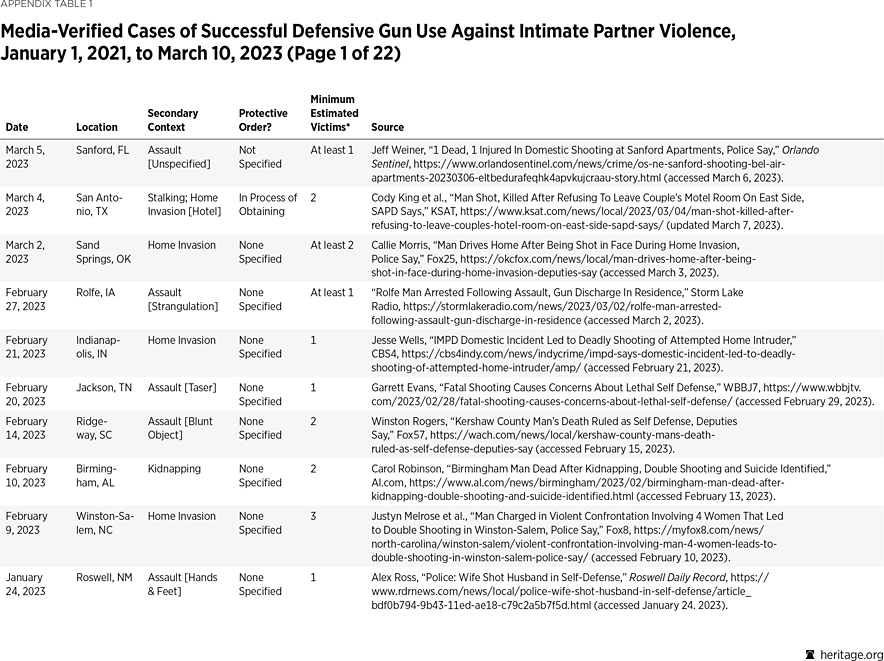
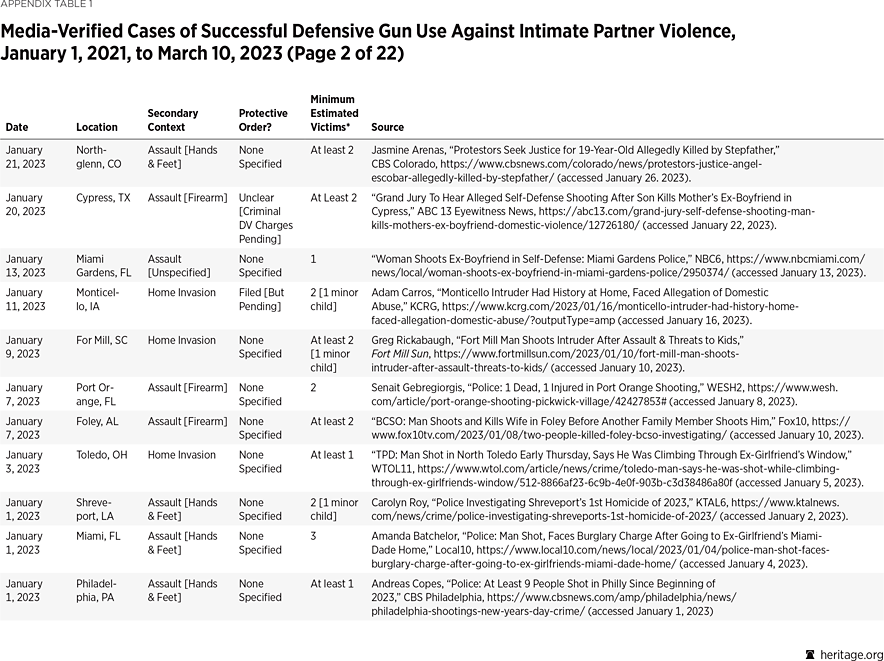
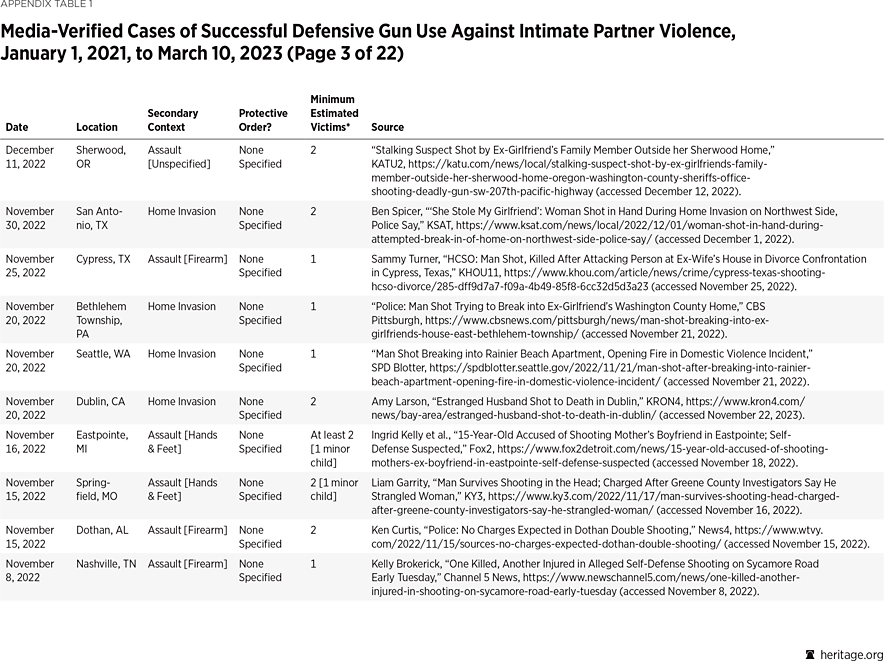
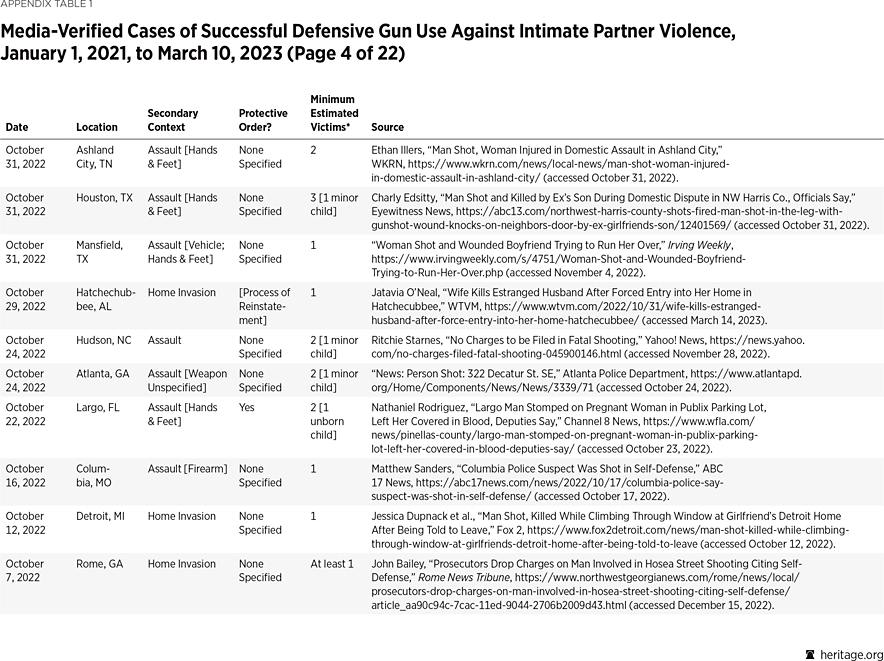
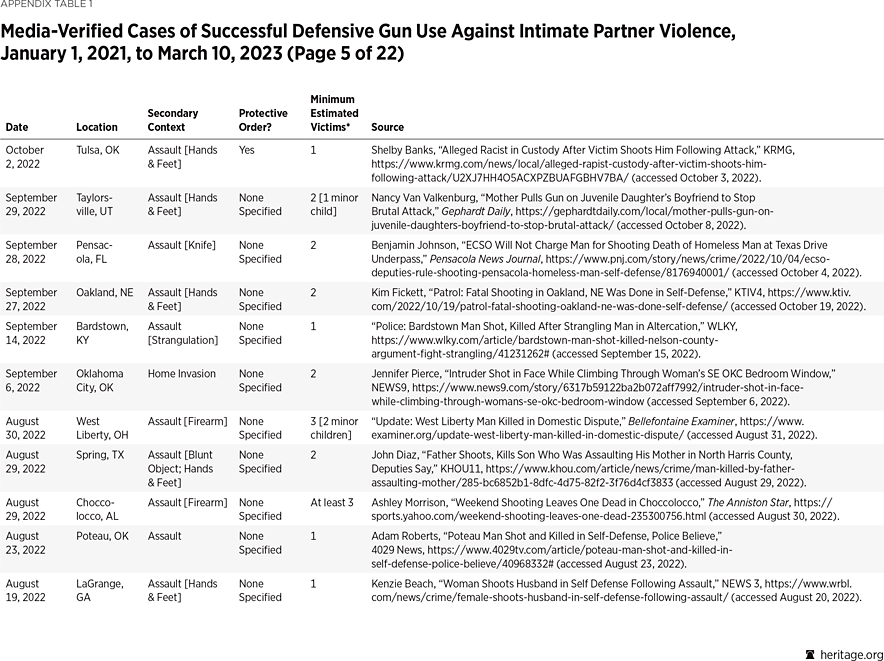
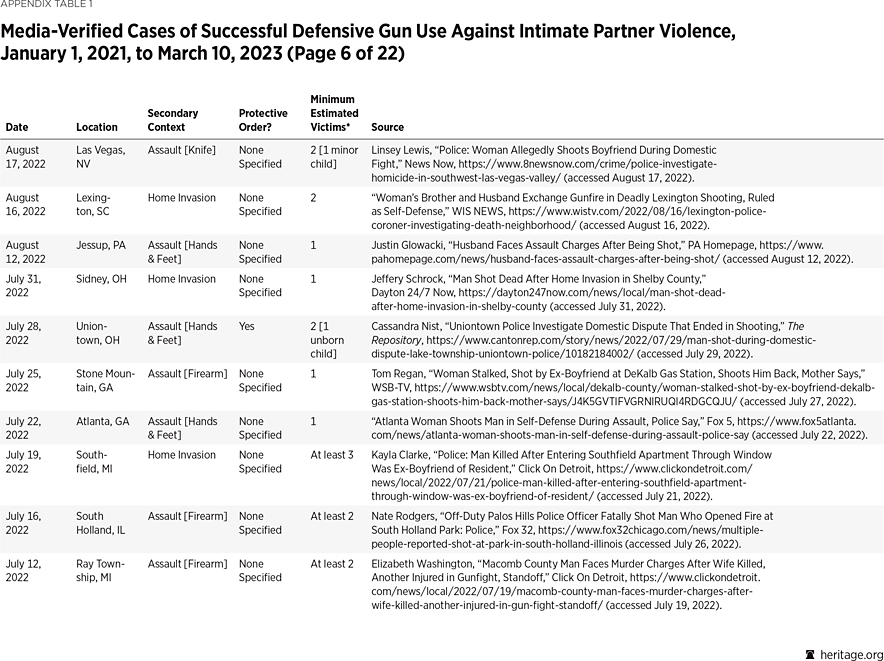
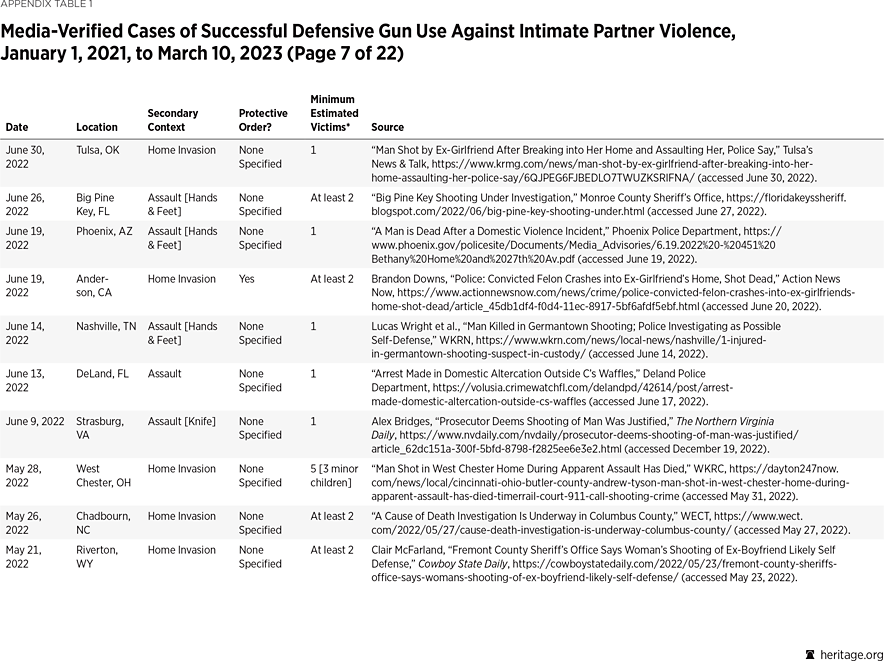
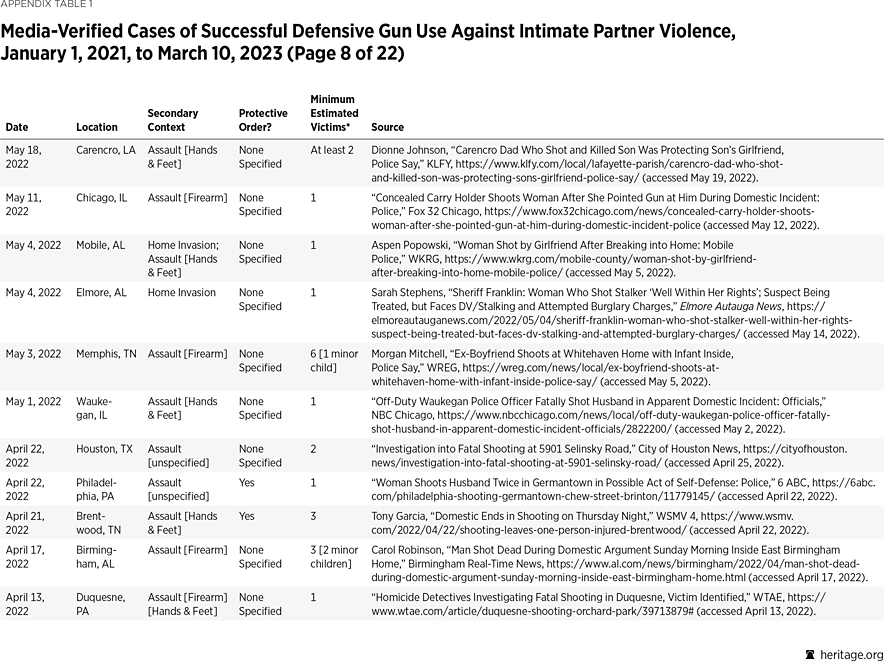
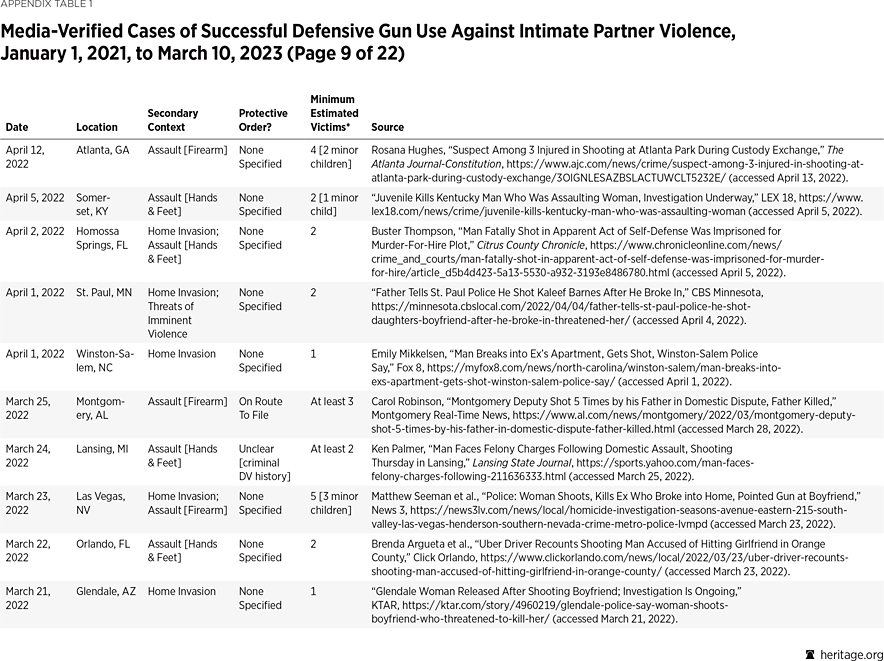
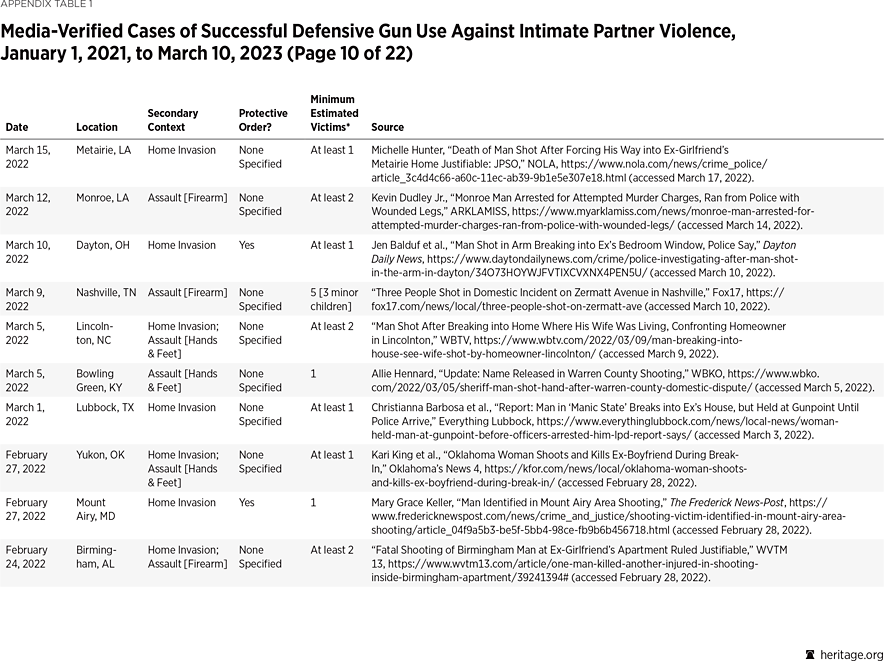
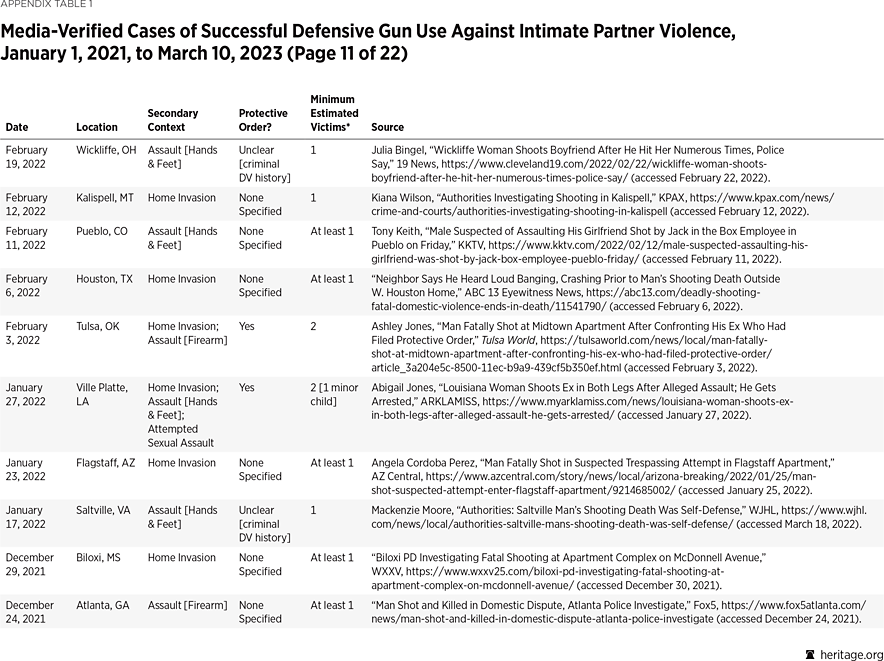
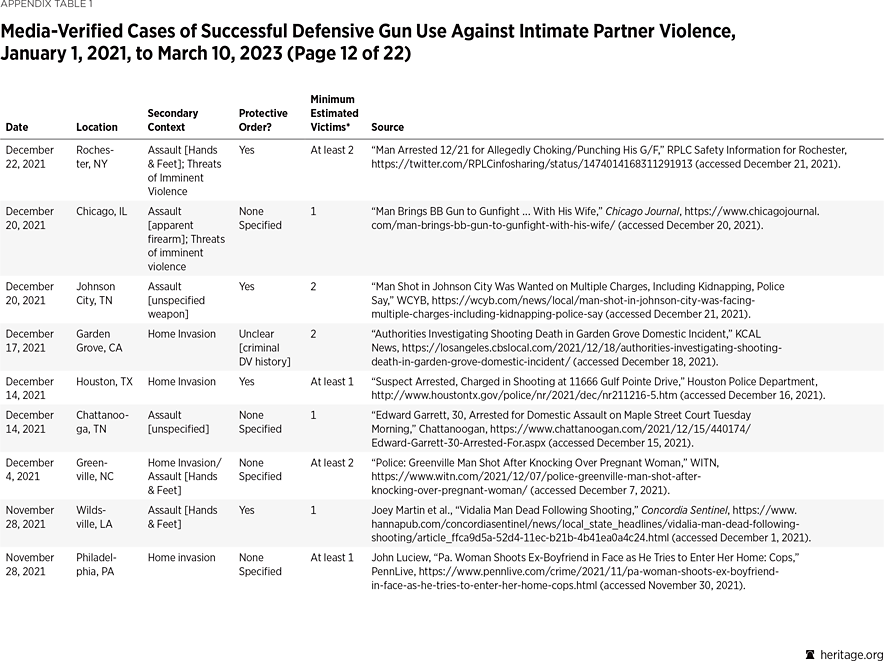
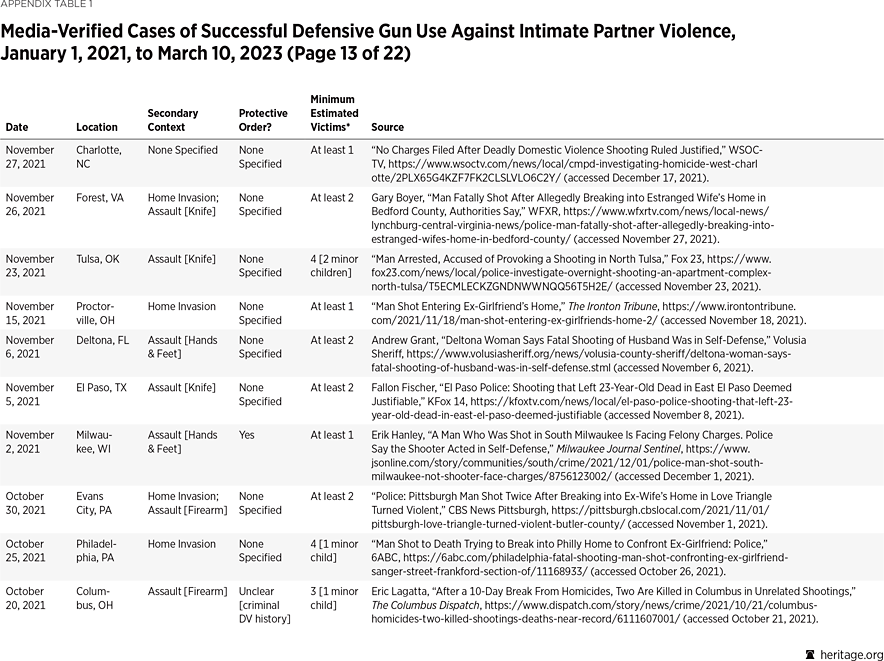
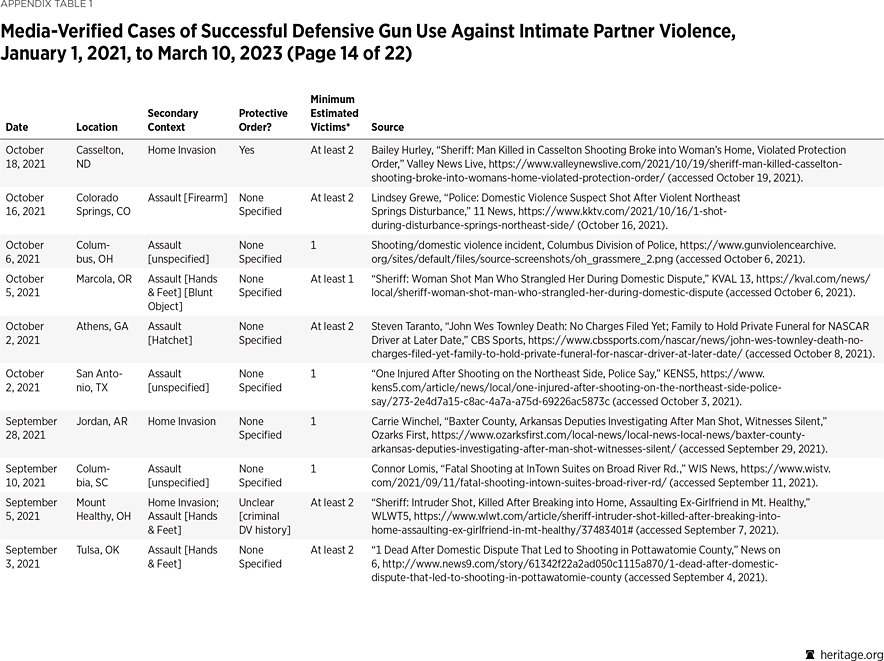
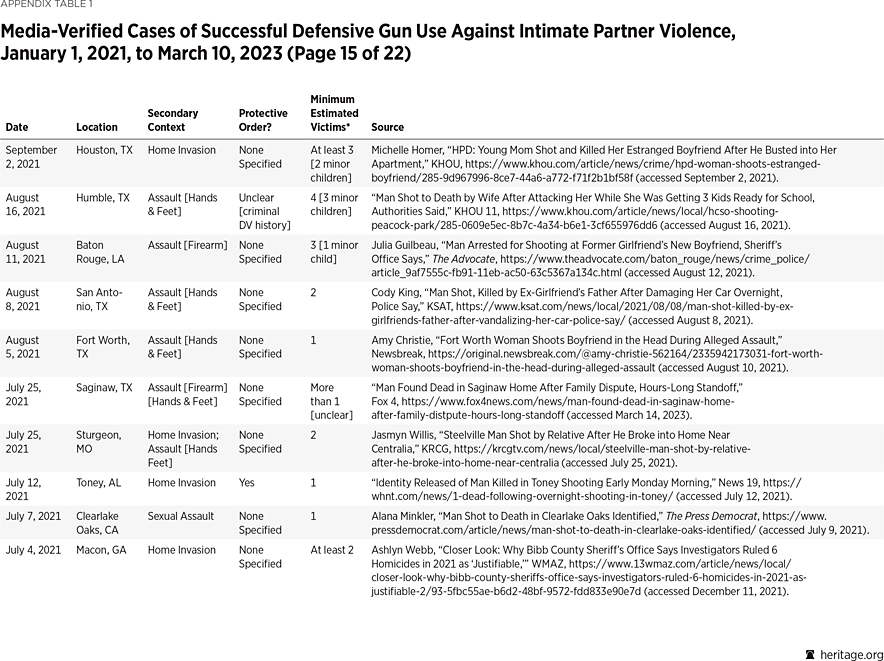
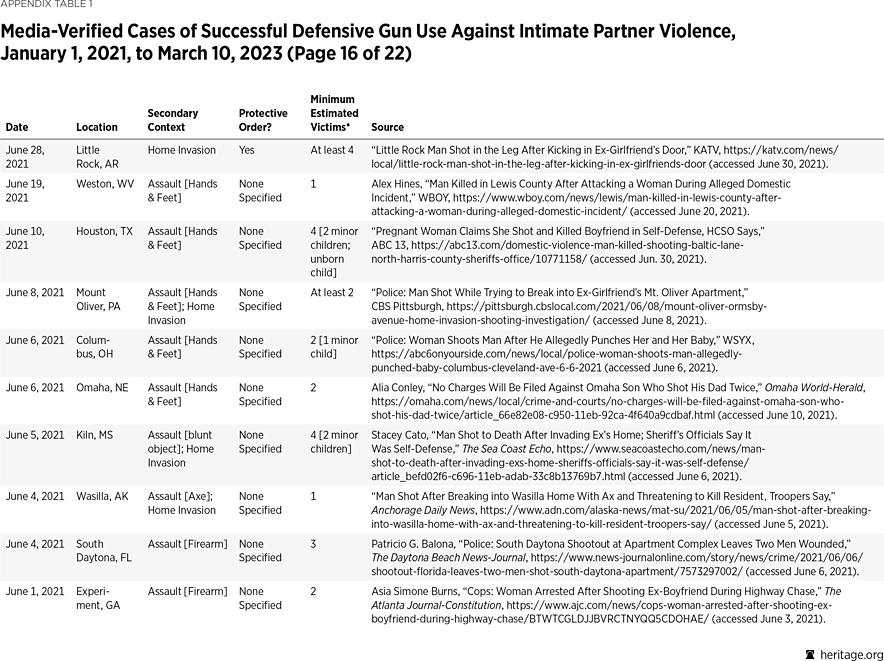
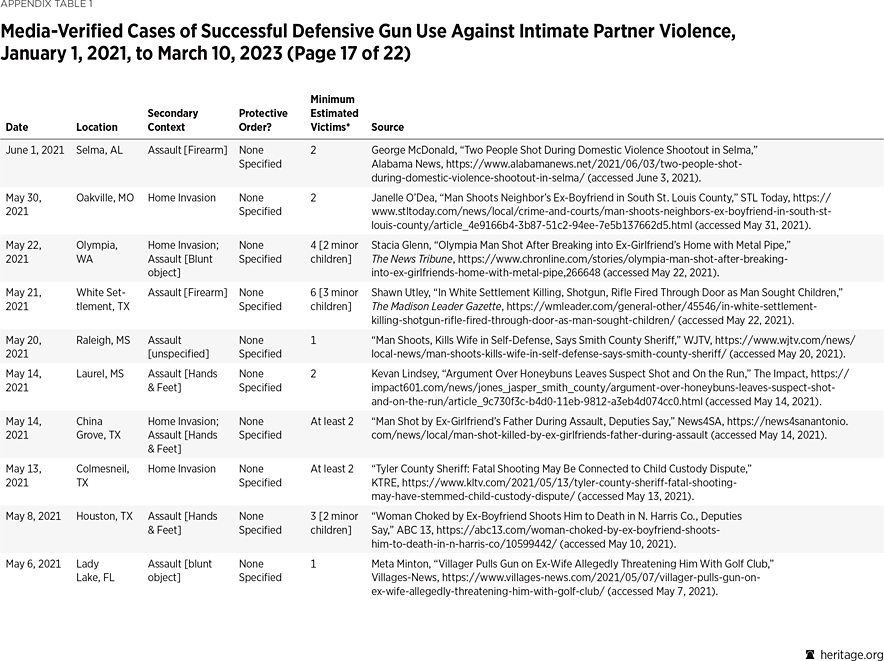
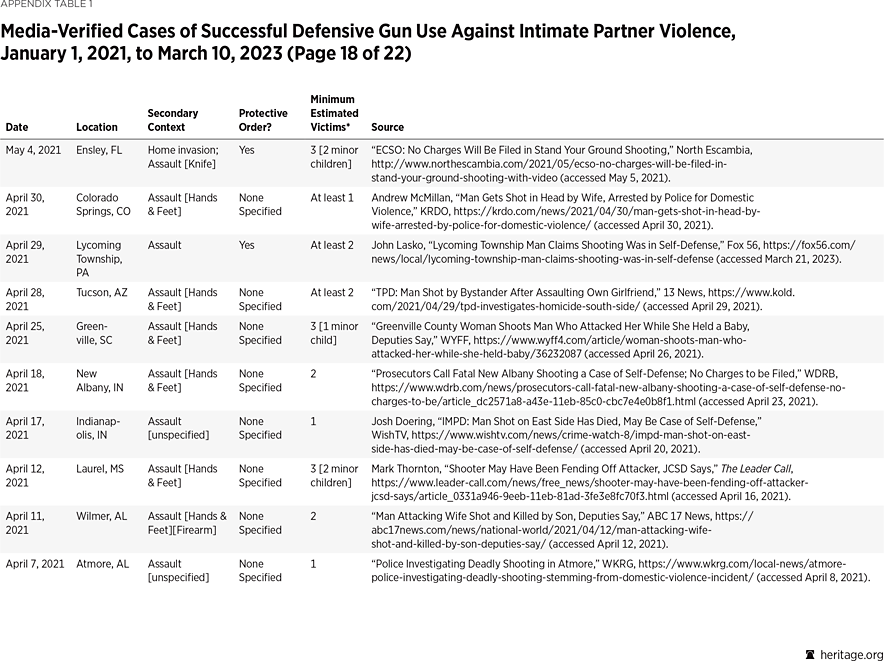
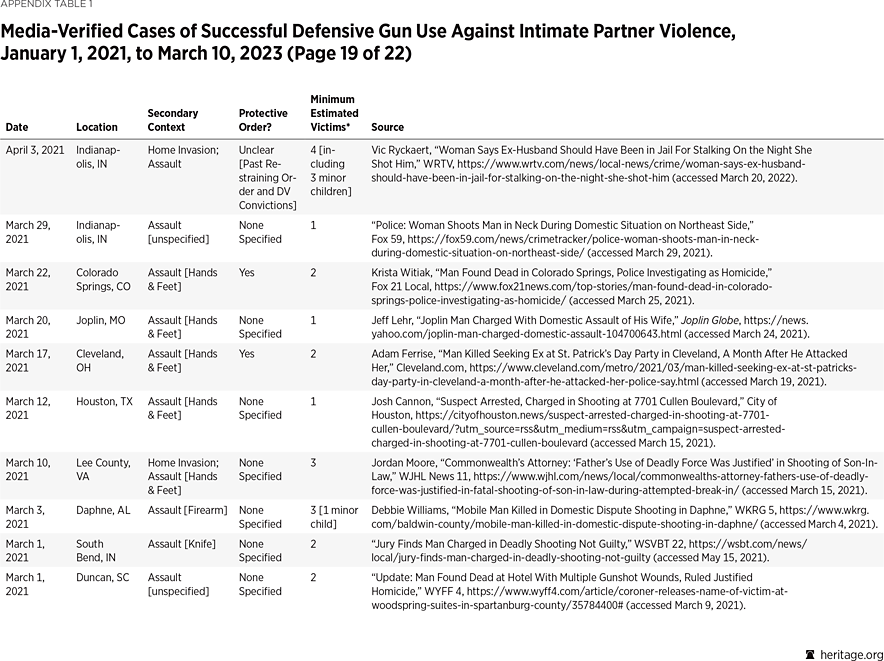
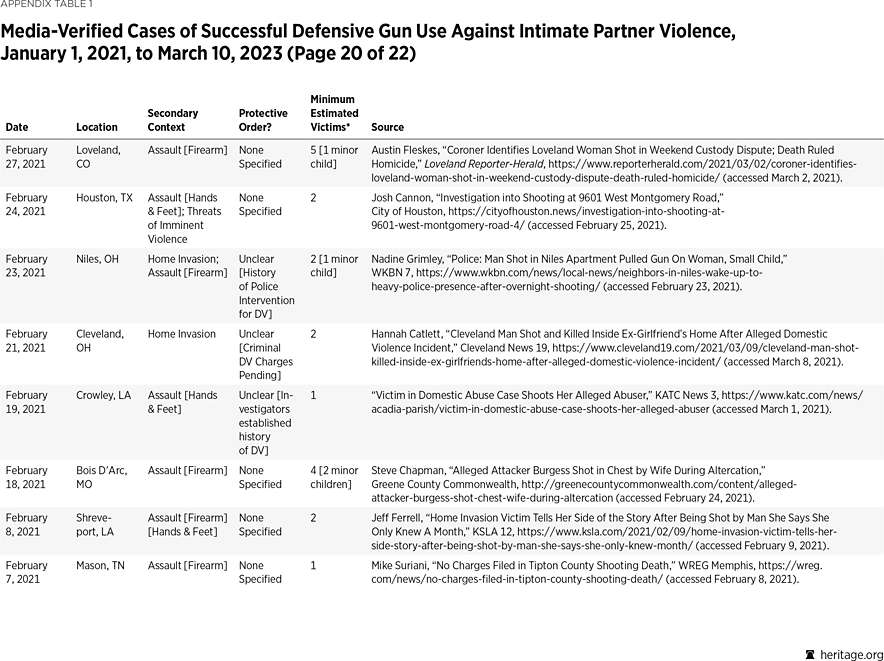
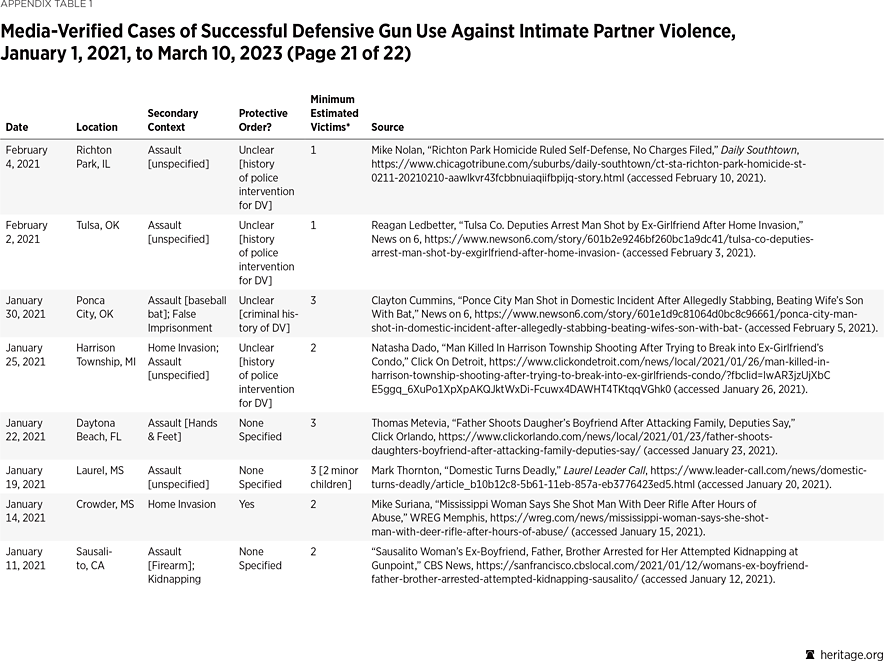
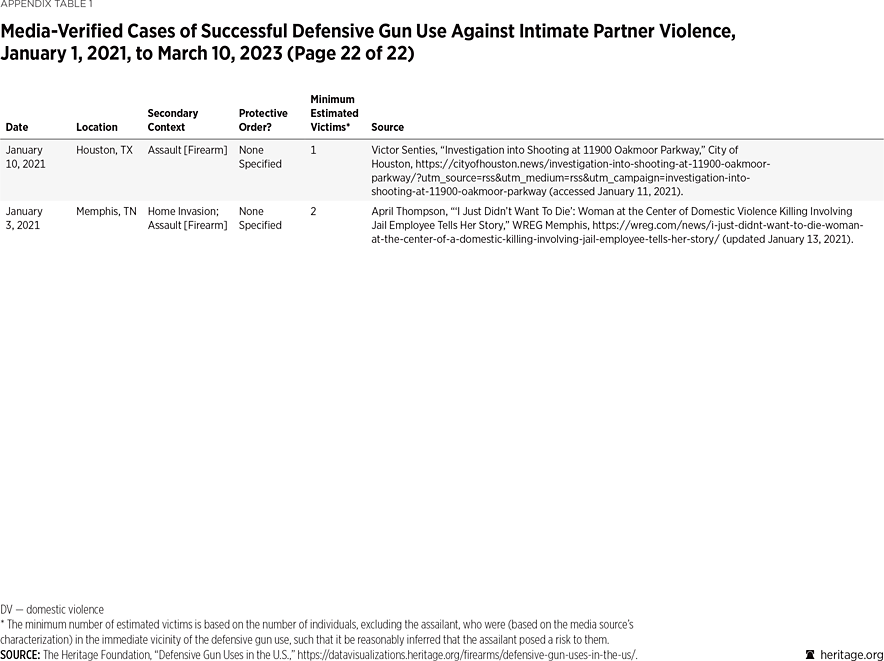
*****
The Heritage Foundation is a public policy, research, and educational organization recognized as exempt under section 501(c)(3) of the Internal Revenue Code. It is privately supported and receives no funds from any government at any level, nor does it perform any government or other contract work.
The Heritage Foundation is the most broadly supported think tank in the United States. During 2021, it had hundreds of thousands of individual, foundation, and corporate supporters representing every state in the U.S. Its 2021 operating income came from the following sources:
Individuals 82%
Foundations 12%
Corporations 1%
Program revenue and other income 5%
The top five corporate givers provided The Heritage Foundation with 1% of its 2021 income. The Heritage Foundation’s books are audited annually by the national accounting firm of RSM US, LLP.
Members of The Heritage Foundation staff testify as individuals discussing their own independent research. The views expressed are their own and do not reflect an institutional position of The Heritage Foundation or its board of trustees.
